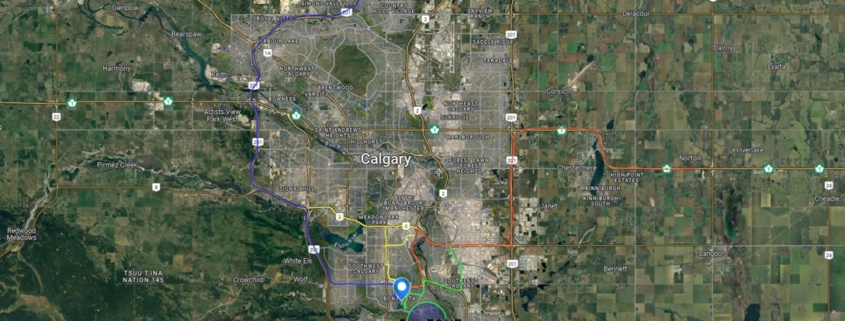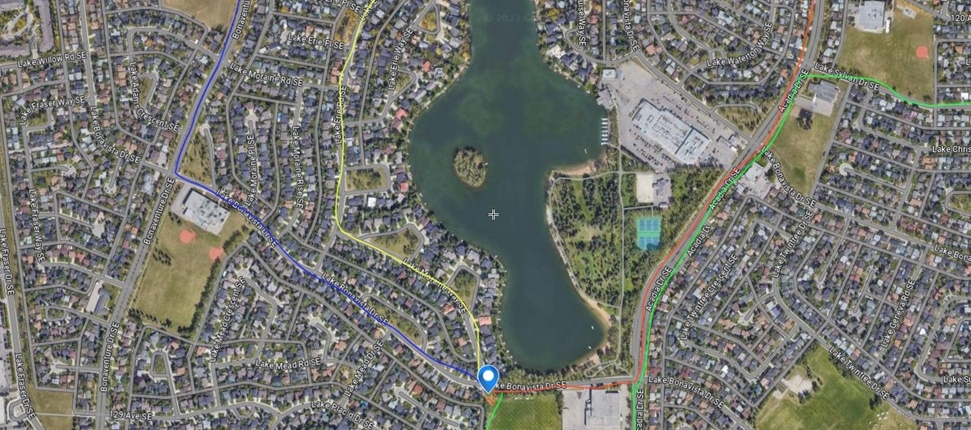How to Create an Evacuation Plan and Route
In the event of an evacuation from your home, there are many moving components. In this post we will address this through a step by step process on how to create an evacuation plan and route that will get you safely out of your community during an emergency. We will use a fictional situation, fictional homes, and fictional characters to outline how this can be done.
Firstly, the following is a statement from the Government of Canada’s “Get Prepared” website: (We will address many of these points further into the article in greater detail)
Evacuation orders
Authorities will not ask you to leave your home unless they have reason to believe that you may be in danger.
If you are ordered to evacuate, take your emergency kit … Bring a cellular phone and spare battery or charger with you, if you have one. Use travel routes specified by local authorities.
If you have time, call or e-mail your out-of-town contact. Tell them where you are going and when you expect to arrive. Once you are safe, let them know. Tell them if any family members have become separated.
If possible, leave a note telling others when you left and where you are. Shut off water and electricity if officials tell you to do so.
Leave natural gas service on unless officials tell you to turn it off. If you turn off the gas, the gas company has to reconnect it. In a major emergency, it could take weeks for a professional to respond.
Take pets with you. Lock your home. Follow instructions from authorities.
If you go to an evacuation centre, register your personal information at the registration desk. Do not return home until authorities advise that it is safe to do so.
Details of our Fictional Situation:
Our fictional story is the following (using popular locations for exaggeration to visualize the process):
- The Smith family:
-
- Mom (peanut allergy), works part time at grocery store
- Dad (main income provider), coaches basketball for his son’s team
- Son (14), in grade 9, has learners license, plays basketball
- Daughter (5), kindergarten, attends day care after school 3 days a week
- Pete the Cat
-
Their current residence is in Lake Bonavista, Calgary Alberta and today they have received word of the need to evacuate parts of the city. There is a wildfire in Fish Creek park that is billowing out of control, with an east wind pushing it. Presently Calgary is in drought conditions. The requested evacuation areas will be shown via a map in a real life situation, below is a faux example. It would look something similar to this (with a color coded legend showing fire location, and evacuation zones).
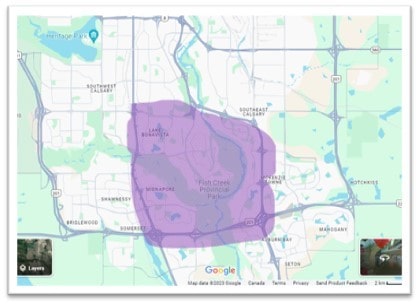 (Purple: Evac zone)
(Purple: Evac zone)
Important Definitions:
- Evacuation Alert: A warning to prepare to evacuate if the situation changes.
- Evacuation Order: this is a mandatory evacuation, meaning immediately. By not abiding, you are potentially putting emergency responders at risk. Follow instructions if this order is put in place. Remember, you will not be asked to leave unless it is of great importance to your safety
- Shelter in Place: Sometimes the situation is best handled to stay indoors where you are. Follow instructions, and keep up to date.
- Evacuation Rescinded: This is the all clear that it is safe to return home. Be sure to seek up to date information on your community.
Types of Evacuations:
- Evacuation of community (due to fire, flood, burst pipes, etc)
-
- Keep a map of the area and prepare multiple routes. GPS is great, but should you have no internet access, a physical map, and knowledge of your routes is important
- Know where to get up to date traffic information
-
- Evacuation of home (due to fire, flood, burst pipes, etc)
-
- Floor plan layout showing emergency exits and escape routes
- Consider upper level homes to have a ladder option for escape
-
- Evacuation of home (due to emotional trauma or personal safety)
-
- *Note, we will not be addressing this specific type of evac during this article, but many of the same concepts do apply, and supports for victims of abuse, or other types of reasons to leave their homes can reach out to a variety of shelters and government agencies
-

The Evacuation Plan In Action:
Step 1: Stay informed and listen for how it affects you directly
Receive notification of an evacuation alert, evacuation order, or shelter in place. In the Smith’s case, they were on an evacuation alert, and then received an evacuation order.  In Alberta we have the Alberta Emergency Alert app. Each province may have a similar system in place.
In Alberta we have the Alberta Emergency Alert app. Each province may have a similar system in place.
Canada also operates Alert Ready. This is our nation-wide system to reach people through radio, television, and compatible cell phones. You can go to the website to see if your phone is compatible to receive notifications.
PRO TIP: Stay Calm. After you hear that emergency alert sound – your body will be freshly flush with adrenaline and you will have a thousand thoughts flooding through your mind. Better to take a few moments, sit down, take some deep breaths, and then begin your plan when you have your mental and physical under control – than to start running around in a craze and make bad choices.
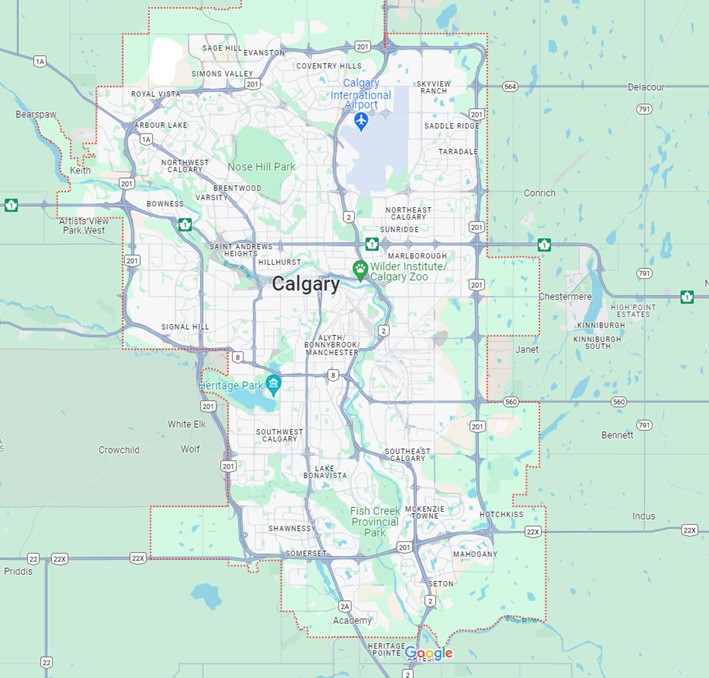
Step 2: Gather Supplies/Gear
The Smith family happen to be scattered when evacuation order comes in. The fire had been burning for 24 hours, and there was an evacuation alert in place already. Dad & Son are 2 blocks over at the community center (staying close to home), while Mom & Daughter are at home, in the middle of preparing supper.
Mom & Dad immediately get on the telephone to touch base with one another, and confirm that Dad & Son are en-route home. Mom & Daughter quickly clean up dinner (turn off the stove and package what is able to be brought with them), and begin loading the already gathered supplies into their vehicle. Having been in a evacuation alert, they had already gathered necessary items, ready to go. The goal the Smith’s practiced for is to be out the door & on the road within 10 minutes.
The Smith’s pack & go list looks like this: Smith family emerg list. In the event of enough time, the additional step of grabbing keepsakes is a part of their plan.
The Red Cross also has an excellent 14 page document to fill in for each family member to store in your emergency binder.
Smith Family Quick Checklist
- 72 hour kit
- Additional emergency gear
- Emergency binder & important document bin
- Grab & Go food bin of snacks plus grab & go water jug
- Electronics – computer, tablets, phones, chargers
- Daughter & Son: given assignments
- Mom: Epi-pen
- Emergency cash
- Pete the cat and his grab & go bag
Note: If you have NOT been advised to evacuate, but are on alert or shelter in place, please respect the instructions of the authorities. Mass panic, stress, and excess people on the roads can cause accidents, and unnecessary traffic, potentially causing danger to those in an evacuation location.
Step 3: Before Leaving Your Home
- Turn off electricity if instructed. If not, be sure all lights and necessary appliances are unplugged
- Turn off water
- Leave a note on the front door indicating all occupants have evacuated safely (follow instructions via local authorities as to how to indicate this)
- Unless instructed, do not turn off natural gas
- Cat supplies & Pete the Cat (or whatever pet(s) you have)
- Lock your home
Tips:
(This is a link to another resource from the Red Cross regarding evacuations)
- Make sure to wear shoes and clothing appropriate for the conditions.
- If time permits and flooding is the emergency, move any cherished items away from flood-able areas (consider storing such items long term in upper levels of home)
- Offer to help any neighbours who may need assistance evacuating.
- Use only the travel routes provided by community officials as you leave. Using a shortcut could take you to a dangerous area or a road that is blocked.
- If you have family members or friends who are camping or hunting in the area, make sure to advise emergency officials.
Step 4: Pre-Mapped Out Evacuation Route
Step 4 is fully portrayed below in extensive detail. This chart sums it up quickly:

Lets Continue:
Part of your evacuation plan will include pre-determined routes out of the city. Know your options. Also, be patient. The Smith’s are in a population dense region of the city. Leaving in a timely order will allow for smoother flow.
The Smith’s have 2 possible destinations chosen in case of an evacuation. They decided that they would choose to have options in case of unforeseen circumstances of one not being available.
#1: Longview, AB – An hour away from the city, on the south side. Grandparents lives here for them to stay with.
#2: Drumheller, AB – Two hours away, to the east. Family friends live there on an acreage.
The Smith’s Mom & Dad discussed the options, and chose Drumheller to avoid heading in the direction of Fish Creek Park (to their south) where the fire was raging, and anticipate with how close the fire is to home, not being able to come back immediately. The friend acreage allows for more space, and more distance from the city. To avoid being on Deerfoot longer than necessary, the Smith’s plan to drive on back roads as often as possible. In their emergency binder they have a map of Alberta, and a map of Calgary.

Scenarios & Factors to Consider:
Fire
- How is the air quality index? This gov of Canada link shows you up to date content within Canada
- Smoke inhalation – keep windows closed if evacuating with personal vehicle
- Which direction is the wind blowing?
- Are all roadways open?
Flood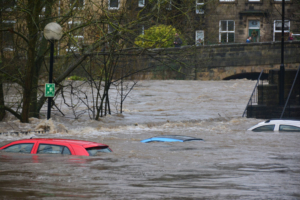
- Does your route involve crossing bridges?
- Does your route travel near or along side any bodies of water?
- Are certain road ways or routes closed that you would typically take?
Other Emergencies
- Power lines down, pipes bursting, or other situations require different responses. Plan your route accordingly to avoid those areas.
- Having to evacuate, but not being able to go home first. This is everyone’s worst nightmare I would imagine. Being evacuated without being able to take any of your personal belongings, or your strategically packed and organized evacuation preparedness supplies:
Remember: Your safety is literally the #1 priority
Shelter Options
- Do you have a location to evacuate to? Or will you be needing to evacuate to a shelter?
-
- A shelter will typically provide basic food, water, sanitation supplies, and first aid. Always bring your grab and go bag when possible if needing to evacuate to a shelter, if anything to assist in alleviating the possible volume the shelter will be supporting. Of course, if you cannot, then rest assured (and possibly a little patience), someone will help you and/or your family!
-
- Is your evacuation location reachable/accessible? Do you have a plan B & plan C?
Transportation
- Do you have a personal vehicle to evacuate? If not, emergency officials will have transportation available to those in dangerous areas. Stay tuned to local news.
- Are you familiar with your local bus or public transportation routes? Taxi or Uber services may not be available, but a quick internet search or phone call can help you determine.
Mapped Routes:
The Smith family lives in Lake Bonavista, in Calgary, AB. Their community is surrounded by 4 major roadways: Anderson Rd & Canyon Meadows Drive, North/South roadways, and Macleod Trail & Bow Bottom Trail, East/West roadways. The (fictional) Fire is encroaching on Canyon Meadows Drive so that roadway is officially closed, along with South-bound Macleod Trail.
They have 4 routes mapped out of their neighborhood & the city (shown above & below respectively with 4 different colors) to get them out of the city, based on road closures, and direction given by authorities.
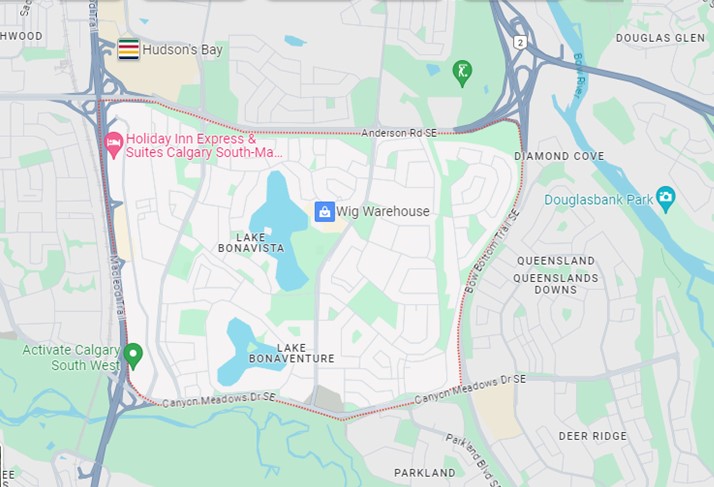
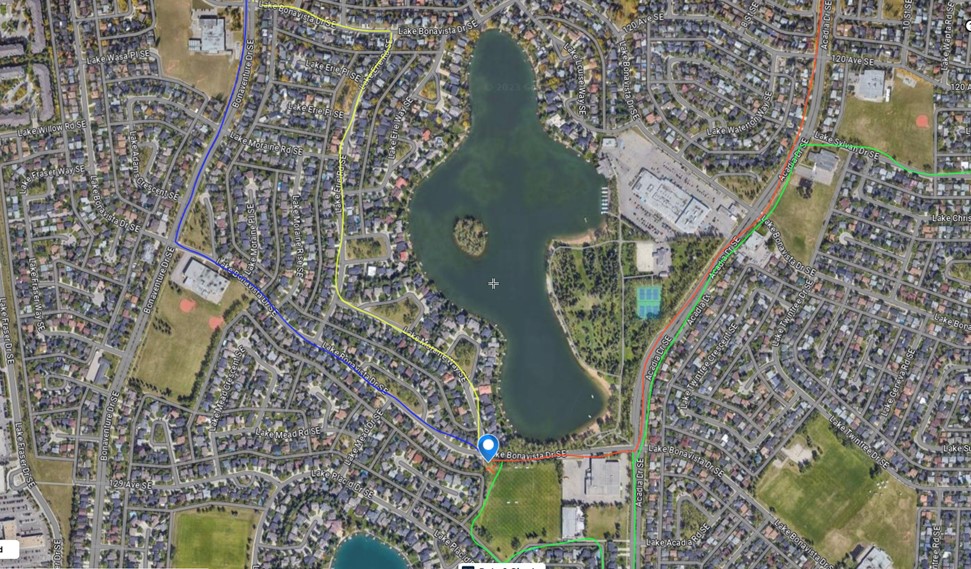
- The communities North of Lake Bonavista (Willow Park, Maple Ridge & Acadia) are on evacuation alert. They have been asked to Shelter in Place, to allow smoother evacuation of the closer-to-danger communities.
- Note: If this emergency were a flood, the Smith family would use a different evac plan, ensuring that personal belongings were secure prior to leaving their home, particularly because they live next to a lake. They have a route in place to get out of their neighborhood, avoiding roadways near the water.
Step 5: Contact Destination
When time permits, the Smith’s contact the family in Drumheller to state they are en-route for an undetermined amount of time.
Once settled in for the drive, the Smith’s start the process of communication to others:
- Contact all the necessary family, neighbors and friends
- Call places of employment stating they are in the evacuation zone, and won’t be to work until further notice.
- Son’s school is outside of the evacuation zone. Email sent to inform them Son will be out until further notice
- Mom directs Son to post in the group chat (from his smart phone) for the basketball team on Dad’s behalf to state that practices were postponed until further notice
- Mom emailed daycare to let them know Daughter wouldn’t be coming until further notice
- Son & Mom checked family calendar, and cancelled or postponed schedule appointments
The After-Math
There are financial programs available to Canadians after an emergency, depending on the details and situation. Be sure to keep any receipts, a log of events during your experience, and all pertinent information (consider a sleeve in your emergency binder). This is a short list just to name a few programs available:
- British Columbia: Disaster Financial Assistance (DFA)
- Alberta: MyAlberta Evacuation Payments
- Gov of Canada: EMAP – Emergency Management Assistance Program for First Nations
- Northwest Territories: Evacuee Income Disruption Program
- Quebec: Financial Assistance related to forest fires
- Get Prepared (Gov of Canada) has a list of all the provinces and territories Emergency Management Organizations (EMO)
Returning Home & Back to Life Post Emergency:
Returning home can cause undue stress and anguish. Utilize emotional supports available. You are not alone. The Alberta.ca site details a lot of post-emergency support and suggestions here. Here we will see how the Smith’s integrate:
- The Smith’s did not return home until they had received confirmation from authorities to do so
- Yard clean up: they were fortunate to not lose their home, but there is lots of ash and smoke to be rinsed and cleaned up
- Home check: be sure everything is working, operating, and safe. If there was any damage, photos & documentation every step of the way for insurance purposes
- The Smith’s went next door to each neighbor to ensure they had made it home safely, and helped out wherever they could
- Monitor yourself and your loved ones for signs of distress, which could include:
- difficulty sleeping
- emotional outbursts
- anxiety
- depression or unexplained physical issues
Here is a list of posts we have created with some further insights and information pertinent to this topic. Also peruse the Academy for other pieces of knowledge:
- Seniors Sheltering in Place
- Creating an Emergency binder
- Building a 72 Hour Kit
- Emergency Food
- Emergency Water
- Flood Preparedness
- It Won’t Happen to Me, Right?
- Is Your Family Ready for a Disaster? 10 Essential Questions to Ask
- Readiness in the Workplace. Creating an Office Plan
- Food Buckets For Emergencies

